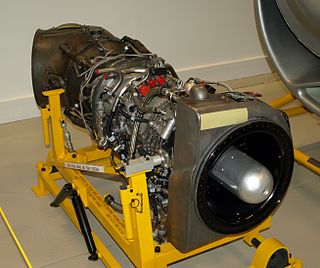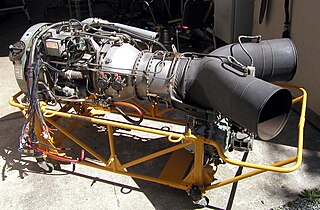
Safran Helicopter Engines, previously known as Turbomeca, is a French manufacturer of low- and medium-power gas turbine turboshaft engines for helicopters. The company also produces gas turbine engines for aircraft and missiles, as well as turbines for land, industrial and marine applications.

The Pratt & Whitney Canada PT6 is a turboprop aircraft engine produced by Pratt & Whitney Canada. Its design was started in 1958, it first ran in February 1960, first flew on 30 May 1961, entered service in 1964 and has been continuously updated since. It consists of two basic sections: a gas generator with accessory gearbox and a free power turbine with reduction gearbox, and is often seemingly mounted backwards in an aircraft in so far as the intake is at the rear and the exhaust at the front. Many variants of the PT6 have been produced, not only as turboprops but also as turboshaft engines for helicopters, land vehicles, hovercraft, and boats; as auxiliary power units; and for industrial uses. By November 2015, 51,000 had been produced, had logged 400 million flight hours from 1963 to 2016. It is known for its reliability with an in-flight shutdown rate of 1 per 651,126 hours in 2016. The PT6A covers the power range between 580 and 1,940 shp while the PT6B/C are turboshaft variants for helicopters.

The Rolls-Royce T406 is a turboshaft engine that powers the Bell Boeing V-22 Osprey tiltrotor. The engine delivers 6,000 shp (4,470 kW).

Rolls-Royce Turbomeca Limited (RRTM) is a joint venture between British aero-engine manufacturer Rolls-Royce plc (UK) and French helicopter engine specialist Safran Helicopter Engines. It manufactured aero-engines and provided associated support services to end users.

The LHTEC T800 is a turboshaft engine for rotary wing applications. It is produced by the LHTEC, a joint venture between Rolls-Royce and Honeywell. The commercial and export version is the CTS800. The engine was primarily developed for the United States Army's cancelled RAH-66 Comanche armed reconnaissance helicopter, but has found use in other applications.

The MTU Turbomeca Rolls-Royce MTR390 is a turboshaft developed for light helicopter applications by MTU Turbomeca Rolls-Royce (MTR). The engine is designed to power helicopters in the weight range of 5-7 tonnes in both single and twin engine configurations. So far the only application is the Eurocopter Tiger. Test runs of the MTR390 began in 1989 and the first test flight was performed in 1991. The MTR390 received military certification in May 1996 and civil approval in June 1997.
The Turbomeca TM 333 is a turboshaft engine manufactured by French company Turbomeca and designed for helicopters weighing 4-5 tonnes. It first ran in August 1981 and was introduced commercially in the mid-1980s. It was the first Turbomeca engine to use a single stage turbine, making it more compact than its predecessors. In its original design, the engine was rated at 750 continuous horsepower, though it was designed to allow for future power increases, and the later 2B2 variant made 1,100 horsepower.

The Napier Gazelle is a turboshaft helicopter engine that was manufactured by D. Napier & Son in the mid-1950s. In 1961 production was nominally transferred to a joint venture with Rolls-Royce called Napier Aero Engines Limited. But the venture closed two years later.

The Rolls-Royce Gnome is a British turboshaft engine originally developed by the de Havilland Engine Company as a licence-built General Electric T58, an American mid-1950s design. The Gnome came to Rolls-Royce after their takeover of Bristol Siddeley in 1968, Bristol having absorbed de Havilland Engines Limited in 1961.

The Bristol Siddeley Nimbus, later known as the Rolls-Royce Nimbus, was a British turboshaft engine developed under license by Blackburn Aircraft Ltd. from the Turbomeca Turmo in the late 1950s. It was used on the Westland Scout and Westland Wasp helicopters.

The Rolls-Royce Gem is a turboshaft engine developed specifically for the Westland Lynx helicopter in the 1970s. The design started off at de Havilland and was passed to Bristol Siddeley as the BS.360. When Rolls-Royce bought out the latter in 1966, it became the RS.360.

The General Electric T700 and CT7 are a family of turboshaft and turboprop engines in the 1,500–3,000 shp (1,100–2,200 kW) class.

The Turbomeca Astazou is a highly successful series of turboprop and turboshaft engines, first run in 1957. The original version weighed 110 kg (243 lb) and developed 240 kW (320 shp) at 40,000 rpm. It was admitted for aviation service on May 29, 1961, after a 150-hour test run. The main developing engineer was G. Sporer. It was named after two summits of the Pyrenees.

The Turbomeca Arriel is a series of French turboshaft engines that first ran in 1974. Delivering 650 to 1,000 hp, over 12,000 Arriel engines have been produced from 1978 to 2018, logging more than 50 million flight hours for 40 helicopter applications. In June 2018, 1,000 Arriel 2D were in service, powering H125 and H130 single-engine helicopters, having logged one million flight hours since 2011. After endurance tests and fleet data analysis, their TBO increased by 25% to 5,000 hours and mandatory inspection rose to 15 years with no hourly limit, lowering maintenance costs.

The Turbomeca Turmo is a family of French turboshaft engines manufacturered for helicopter use. Developed from the earlier Turbomeca Artouste, later versions delivered up to 1,300 kW (1,700 shp). A turboprop version was developed for use with the Bréguet 941 transport aircraft.

The Turbomeca Makila is a family of French turboshaft engines for helicopter use, first run in 1976 and flown in 1977.

The Westland 30 is a medium-sized civil helicopter designed and produced by the British aerospace company Westland Helicopters. It was derived from the Westland Lynx series of military helicopters, with which it retains a high level of commonality.

The Safran Ardiden is a 1,400–2,000 hp (1,000–1,500 kW) turboshaft designed and produced by Safran Helicopter Engines for 5–8 t (11,000–18,000 lb) single and twin-engine helicopters. Launched in 2003 as a more powerful TM 333, it first ran in 2005 and was introduced in 2007. The Ardiden 1 Shakti powers the Indian HAL Dhruv, Light Combat Helicopter and Light Utility Helicopter while the more powerful Ardiden 3 powers the Avicopter AC352 and Kamov Ka-62.

The AgustaWestland AW189 is a twin-engined, super-medium-lift helicopter manufactured by Leonardo S.p.A. It is derived from the AW149, and shares similarities with the AW139 and AW169.
The Safran Arrano is a turboshaft engine for two-to-three ton single-engine and four-to-six ton twin-engine helicopters, developed by Safran Helicopter Engines, outputting 1,100 to 1,300 hp.



















